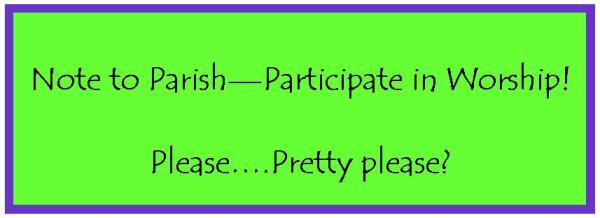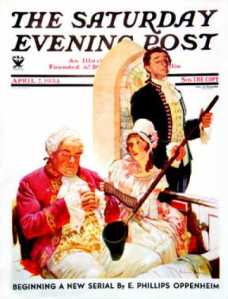
The following bits in italics were in the latest newsletter from an Episcopal Church. They have been excerpted and paraphrased from a very long piece.
Participation in Liturgy: The Episcopal Church, being a body which straddles the line between the Catholic and Protestant traditions, has inherited liturgies which include various types and variations of congregational participation.
Clearly something is not happening on Sunday mornings. There is An Issue. The organist/choir director is going to change everything with a message in the newsletter. Anyone who has assembled something from Ikea, knows first-hand reading instructions alone do not get the job done. Any parent or teacher can tell you the same thing.
From the beginning of the English Reformation, The Episcopal/Anglican Church has had to live within a tension that originated in the liturgical compromises that were made at the creation of the English Church.
Thanks, organist guy! That explains everything. There were compromises made among the ruling elite 500 years ago. Why with this explanation, I’m now ready to leap off the couch and show up Sunday mornings.
How does the congregation participate in the service? The first and most obvious way is to respond vocally to the clergy during the spoken parts of the service.
Count me in! Are we allowed to go off script? What’s the culture of worship in your parish? If a parishioner were to say “Tell the truth!” or a simple “Amen”, would that make it as a chuckle – or even a scandal – at your Tuesday morning staff meeting?
The second way is to sing joyfully (and loudly) during the hymns; if you don’t know the hymn very well, read along during the first verse and give the second verse a try. Don’t just stand there!
While the organist accepts that not many people are literate in music, he doesn’t realize that an important part of the congregation does not read at all. John Bell of the Iona Community is very clear about how powerful it is to employ songs and hymns that are accessible to all, and admonishes us to lead people in song, teach the congregation before the service. This article also implies that the wagons are circled: if you didn’t get the newsletter, if you didn’t read the newsletter, if you walk in off the street, your voice is not important. And if your voice isn’t important literally, then I would guess your voice isn’t important to this Episcopal church anywhere else.
When the lectors are reading lessons, or the clergy is praying, don’t just listen: pray with them. When the choir is singing, read the text and lift up your heart in prayer.
Maybe because the clergy and musicians are set up next to the cross and not down with the congregants, they’re unaware that people pray all the time during a liturgy. “Dear God, don’t make it be Howells again.” Or “Lord, will the sermon address living a Christian life…for real?” Or “Could the choirmaster blow the dust off the one parish copy of Lift Every Voice and Sing?”
What he’s really asking the majority sitting in the church nave to do is make our interior prayer life line up with that of the staff. Don’t have your worship in the Episcopal Church be transformational, creating an environment where everyone is changed “from glory to glory”. And whatever you do, don’t make space for The One who inspires worship. No silence, no call to hear the voice of the faithful unless it’s a response from a book or a licensed lector.

The tradition of participation in our church is beautiful and multi-layered. Let us come together to make our worship as meaningful and inspiring as possible.
Who is the “us” that this earnest organist/choir director wants to come together? It seems to be just the staff. In this message, he even refers to having the psalm performed by the choir (coupled with a reminder that this is not a performance) while the congregation is told to meditate on the words of the psalm. These are our psalms, handed down to us from the time of David. Why take them out of our mouths and limit our participation?
How could anyone consider this participation multi-layered? We are welcomed only when we do what we’re told by the Nanny Church. Sing when told, listen when told, read the script but not the scripture. Don’t just stand there, but don’t dance or clap either. Where is the beauty? Not in the variety of ways God’s faithful people are inspired to worship, only in those who are trained to worship “correctly”.

The saddest irony in this well-intentioned but misguided piece is that people do not learn or change by reading something. There is a part of the brain that yearns for the spiritual, the liturgical, and it’s not the part listening to a run down on Post Reformation history. What’s next? Glebes?
From a 2007 interview with Elsie Rempel, Director of Christian Education and Nurture for Mennonite Church, Canada:
How does insight into brain activity shed light on worshiping with children?
Elsie: Sometimes we talk about worship that connects with our left and right brain. But our brain also has a stem and an inner brain that control our actions and emotions. The inner brain is the part that connects with our passions, intuition, relationality, and our awareness of metaphysical connections. It is in this brain part that recent brain research has attempted to track spiritual experience. The inner brain appears to be hardwired for spiritual activity from birth or before, and remains resilient even in the face of Alzheimer’s and other brain disease. We connect with these parts of the brain in the ritual actions, prayers and musical parts of worship.
The readers of this blog are smart enough to know that Mr. Rempel is talking about active participation and that this has implications for all generations who may be seeking a community for their faith.
The Mennonites: I’m so glad The Episcopal Church might be in communion with this denomination. Let’s really listen to what they have to say to us. That would be another thing to give this skeptical Episcopalian hope.

